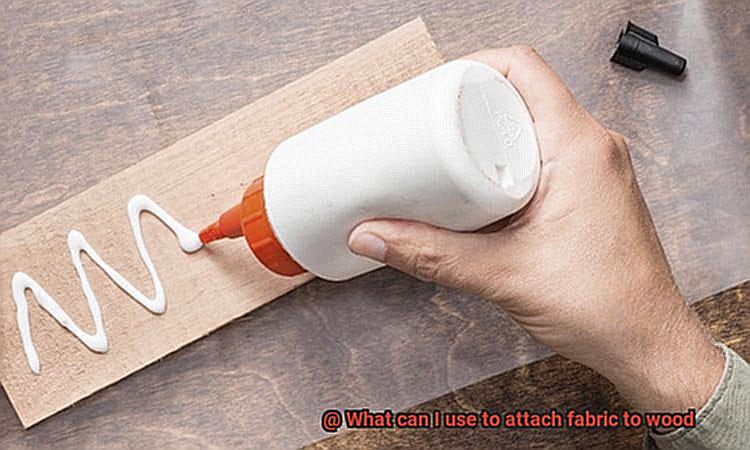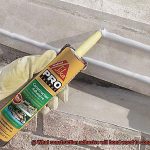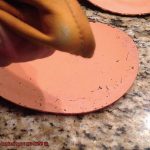Ever gazed upon a wooden piece and felt it lacked that certain oomph? Or perhaps you yearn to add a touch of softness and elegance to a plain wooden frame? Well, fret no more, my friends, for I am about to reveal a secret that will revolutionize your interior design game—fabric and wood fusion. Yes, you heard me right. By combining these two distinct materials, you can effortlessly transform ordinary wood into awe-inspiring works of art that radiate charm and sophistication.
But let’s address the elephant in the room: How exactly can you attach fabric to wood? Fear not, dear readers, as I take you on an enchanting journey through a world of crafting possibilities with an array of captivating solutions.
Adhesive Sprays: Enter the realm of magical aerosol cans that offer mess-free bonding between fabric and wood. These wondrous sprays ensure a secure attachment that stands the test of time. Bid farewell to the tedium of glue application and embrace the convenience of spray adhesives.
Fabric Glue: Perfect for smaller or intricate projects, fabric glue grants you a formidable bond that defies the passage of time. Easy to use and drying clear, it allows your fabric’s patterns to truly shine.
Staple Gun: If you’re aiming for a rustic or industrial look, turn to the trusty staple gun as your loyal companion. With its satisfying “click” and minimal effort required, this tool discreetly secures fabric to wood while leaving behind a clean and stylish finish.
Nail Gun: For those seeking permanence without sacrificing aesthetics, behold the mighty nail gun—a ticket to success. By carefully tacking fabric onto wooden surfaces, you can achieve seamless fusion between both materials.
In conclusion, whether you’re an experienced DIY enthusiast or a curious novice seeking a captivating project to enhance your space, attaching fabric to wood offers a gateway to boundless creativity. So, roll up your sleeves, gather your materials, and embark on a transformative journey that breathes life into your wooden masterpieces. Remember, the only limit is the vast expanse of your imagination.
Advantages of Attaching Fabric to Wood
Contents
- 1 Advantages of Attaching Fabric to Wood
- 2 Types of Glue and Adhesives for Fabric-to-Wood Applications
- 3 Using a Staple Gun or Upholstery Tacks
- 4 Hook-and-Loop Fasteners for Temporary Attachment
- 5 Adhesive Sprays and Double-Sided Tapes
- 6 Using Wood Screws or Nails for Heavy Fabrics
- 7 Selecting the Appropriate Method of Attachment
- 8 Preparing the Surfaces for Better Adhesion
- 9 Conclusion
Wood, with its timeless appeal, is a staple material that adds warmth and character to any space. But have you ever wondered what happens when fabric meets wood? The fusion of these two elements opens up a world of design possibilities, where your imagination can run wild. In this article, we will delve into the advantages of attaching fabric to wood, exploring how it can revolutionize the way you envision and experience furniture, walls, and other wooden structures.
Versatility: A Playful Symphony of Colors, Patterns, and Textures
When you attach fabric to wood, you unleash a symphony of versatility in design and customization. Imagine being able to transform dull furniture or plain walls into vibrant masterpieces that reflect your unique style and preferences. With an endless array of colors, patterns, and textures available in fabrics, you can create captivating designs that are as individual as you are. From bold pops of color to intricate patterns, fabric empowers you to breathe life into your wooden canvas.
Softens the Look: Where Warmth Meets Comfort
Wood exudes a traditional and solid aesthetic that may not always align with the desired atmosphere or theme of a space. However, by attaching fabric to wood, you have the power to soften its overall appearance, creating an inviting and visually appealing ambiance. The combination of fabric’s softness with the natural warmth of wood strikes a harmonious balance that adds coziness and comfort to any setting. Suddenly, your wooden surfaces become more than just stoic structures; they become welcoming havens.
Adds Comfort: Embrace the Perfect Union of Durability and Cushioning
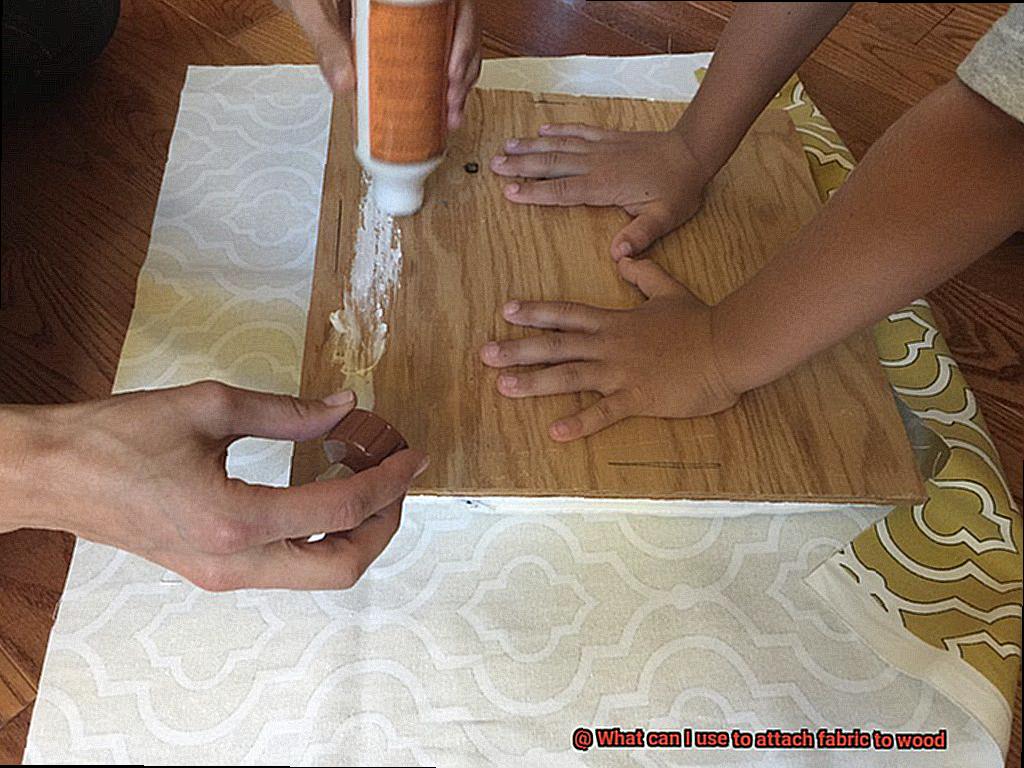
While wooden furniture is known for its durability and sturdiness, it may sometimes lack the comfort factor that comes with padded or upholstered pieces. By attaching fabric to wood, you can seamlessly introduce cushioning and padding to chairs, benches, or seating areas, transforming them into cozy sanctuaries. No longer will you have to sacrifice comfort for the natural charm of wood. Whether it’s sinking into a plush upholstered headboard or settling onto a comfortably cushioned dining chair, fabric enhances your levels of relaxation while keeping the essence of wood intact.
Types of Glue and Adhesives for Fabric-to-Wood Applications
In the world of crafts and upholstery, attaching fabric to wood requires the right glue or adhesive to ensure a strong and long-lasting bond. This article delves into the different types of glues and adhesives commonly used for fabric-to-wood applications, offering insights to help you make an informed decision.
Fabric Glue:
Fabric glue is a tailor-made adhesive designed specifically for bonding fabric materials together. Available in liquid, gel, or spray form, fabric glue offers versatility in application. Its clear drying properties make it ideal for projects where aesthetics matter. However, it might not be the most reliable choice for heavy-duty fabric-to-wood bonding.
Wood Glue:

Wood glue, also known as carpenter’s glue or PVA glue (polyvinyl acetate), is a popular adhesive in woodworking projects. It excels at bonding wood surfaces together but can also work well for attaching fabric to wood surfaces. However, it may not provide the necessary flexibility for certain fabrics or applications.
Spray Adhesive:
For those seeking convenience and efficiency, spray adhesives are a go-to option. Available in aerosol cans, they offer quick and uniform coverage. Spray adhesives find common use in upholstery projects that require fabric attachment to various surfaces, including wood. However, it is crucial to select a spray adhesive specifically formulated for fabric-to-wood applications.
Epoxy Resin:
When strength and durability are paramount, epoxy resin is an excellent choice. Comprising two components – resin and hardener – epoxy requires careful mixing before application. It forms an exceptionally strong bond between fabric and wood but demands cautious handling due to its toxic nature and longer cure time.
Contact Cement:
Contact cement stands as a popular adhesive choice for bonding fabric to wood. It is typically applied to both surfaces being bonded and allowed to dry before joining them. Contact cement guarantees an instant and robust bond, making it suitable for various fabric-to-wood applications. However, due to its strong odor, proper ventilation is vital when using contact cement.
Using a Staple Gun or Upholstery Tacks
Unlocking the secret to a flawless fabric-to-wood connection is like discovering a hidden treasure. In our quest for perfection, we have explored various adhesive options. Now, let us embark on a journey through the realms of staple guns and upholstery tacks. These mighty tools offer secure and enduring holds, but what sets them apart? Join me as we delve into the differences between using a staple gun or upholstery tacks to fasten fabric to wood.
The Mighty Staple Gun:
Picture a tool that effortlessly conquers multiple projects, including the sacred art of attaching fabric to wood – behold, the staple gun. This versatile warrior drives metal staples into the wood, firmly securing the fabric in place. Whether you opt for manual or electric, staple guns offer convenience for projects of all sizes.
Choosing the Chosen Staples:
The key lies in selecting the perfect staples for your staple gun. When it comes to attaching fabric to wood, narrow crown staples reign supreme. These slender warriors minimize the risk of harming precious fabrics. To ensure a rust-free future, stainless steel staples are your loyal companions.
Mastering the Staple Gun Technique:
To triumphantly attach fabric using a staple gun, commence by positioning it atop the wood surface and clutching it firmly. Align the staple gun perpendicular to the wood and unleash its mighty trigger to drive staples deep into both wood and fabric. For symmetrical glory, begin from one side and conquer every inch with even distribution.
The Allure of Upholstery Tacks:
For those who seek a touch of elegance and decorative prowess, upholstery tacks emerge as the shining stars. These dainty metallic gems come in various styles and finishes, allowing you to showcase your unique flair. Upholstery tacks secure fabric tightly when hammered or pressed into wood.
Preparation: The Key to Upholstery Tack Mastery:
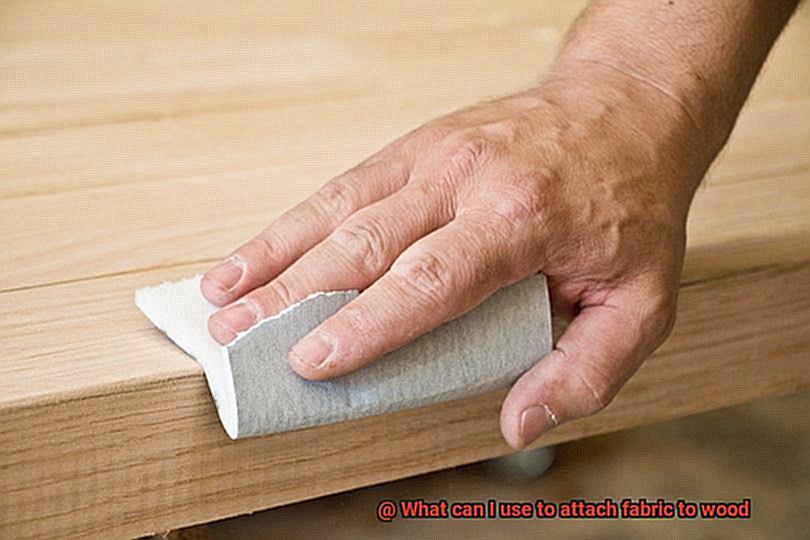
Before embarking on a journey with upholstery tacks, one must prepare the noble wood. Pre-drill holes, dear craftsmen, to safeguard against treacherous splitting and cracking. Remember, the size of the hole must match the diameter of the noble tack shaft. As the fabric lays in its desired position, gently tap each tack into place using a hammer or mallet.
Hook-and-Loop Fasteners for Temporary Attachment
In the realm where fabric meets wood, finding the perfect method to bring them together can be like unearthing buried treasure. We’ve already explored the wonders of staple guns and upholstery tacks, but now it’s time to delve into the enchanting world of hook-and-loop fasteners.
These versatile gems, known far and wide as Velcro, have become a sought-after solution for temporarily attaching fabric. So, let’s unravel their advantages and considerations together.
Advantages of Hook-and-Loop Fasteners:
- Easy Removal and Repositioning: The true magic of hook-and-loop fasteners lies in their ability to provide a temporary attachment that can be effortlessly removed and repositioned. Bid farewell to worries about damaging your beloved fabric or wood surfaces. Whether you’re experimenting with different designs or seeking flexibility for removable panels, hook-and-loop fasteners have got your back.
- A Symphony of Versatility: The symphony of possibilities with hook-and-loop fasteners is music to any designer’s ears. These fasteners come in a variety of sizes and strengths, offering an endless repertoire. For lightweight fabrics or smaller projects, a lighter-duty fastener will serenade you with its delicate touch. However, when dealing with heavier fabrics or larger panels, let the crescendo of a heavier-duty fastener ensure a secure attachment. The choice is yours to compose.
Using Hook-and-Loop Fasteners:
- Cut and Prepare: Let’s set the stage by cutting the hook-and-loop fastener into appropriately sized strips. It is crucial to ensure compatibility by cutting both the hook and loop sides. Once prepared, remove the adhesive backing from one side and press it firmly onto the wood surface, like placing the first note on a sheet of music. Repeat this process with the other side, harmoniously aligning both sides correctly.
- Lock and Load: With both sides of the fastener in position, it’s time to weave the symphony together. Press them together firmly, creating a harmony that resonates with strength. The tiny hooks on one side will dance and interlock with the loops on the other side, securing your fabric to the wood surface in a mesmerizing bond. It’s like magic. And should you ever need to remove or reposition the fabric, simply pull apart the hook-and-loop fasteners and adjust as desired, allowing the music to flow once again.
Adhesive Sprays and Double-Sided Tapes
Say goodbye to the hassle of sewing and nailing – adhesive sprays and double-sided tapes are here to revolutionize the way you attach fabric to wood.
As an expert in this field, I have delved deep into the world of adhesive solutions, uncovering valuable insights on these two remarkable options. Join me as we explore the advantages and considerations of using adhesive sprays or double-sided tapes for your fabric and wood projects.
Adhesive Sprays: Unleash the Magic Mist
Step into a world of effortless attachment with adhesive sprays, also known as fabric or craft sprays. These specially formulated adhesives are designed to bond fabric to various surfaces, including wood. Here’s why adhesive sprays are a game-changer:
- Easy Application: Bid farewell to complexity. Applying adhesive sprays is a breeze. Simply cleanse and prepare both the fabric and wood surface, give the can a vigorous shake, and unleash a fine mist that evenly coats both materials.
- Repositionable Bond: Embrace the freedom of perfection. Adhesive sprays offer a temporary bond that allows you to reposition your fabric before it sets permanently. Achieve flawless alignment with ease.
- Even Coating: Let consistency be your companion. Adhesive sprays provide an even coating on both the fabric and wood, promoting a robust bond that stands the test of time.
Double-Sided Tapes: Joining Forces with Style
Prepare for a bonding experience like no other – enter the realm of double-sided tapes. These adhesive wonders offer an array of benefits when it comes to attaching fabric to wood:
- Unyielding Bonding Power: Double-sided tapes boast adhesive on both sides, ensuring an unbreakable union between your fabric and wood surfaces. Available in various widths, thicknesses, and strengths, they cater to the unique needs of your project.
- Effortless Repositioning: Flexibility is at your fingertips. Just like adhesive sprays, double-sided tapes offer a temporary bond that enables you to reposition your fabric until it reaches the perfect placement. Ideal for intricate or large fabric pieces that require meticulous positioning.
Using Wood Screws or Nails for Heavy Fabrics
Title: The Perfect Fix: Achieving Strength and Style with Wood Screws or Nails for Heavy Fabrics
Introduction:
Welcome back, fabric enthusiasts. In our previous exploration of fabric-to-wood attachments, we delved into the magic of adhesive sprays and double-sided tapes. But what about those heavy fabrics that demand a more robust solution? Fear not. Today, we venture into the world of wood screws and nails, unlocking their hidden potential as sturdy companions for heavyweight textiles. Grab your tools, for we are about to embark on a journey of strength and style.
The Unparalleled Might of Wood Screws:
When it comes to attaching heavy fabrics to wood, wood screws reign supreme as the superheroes of attachment. With their exceptional grip and durability, they provide the ultimate solution for securing weighty textiles to wooden surfaces. Choose from a wide range of lengths and gauges to tailor your attachment precisely to the fabric’s thickness and the type of wood you’re working with.
Step by Step: Mastering Fabric-to-Wood Attachment with Wood Screws:
Begin by positioning your fabric on the desired wood surface, ensuring it is stretched taut, free from any unsightly wrinkles or folds. Armed with either a trusty screwdriver or a power drill equipped with a screwdriver bit, gently drive the wood screw into both the fabric and wood. Strike the perfect balance between security and gentleness, creating a hold that is steadfast without causing any damage or tears to your precious fabric.
Amplifying Potential: Nails as Alternatives:
While wood screws reign supreme, nails too have their place in attaching heavy fabrics to wood surfaces. It’s important to note that nails may not offer as strong of a hold due to their smaller surface area and thinner structure. To maximize their effectiveness, opt for larger-sized nails with flat heads or small washers attached. This strategic choice helps distribute the force applied during hammering, minimizing the risk of tearing or ripping the fabric.
Proceed with Caution: Reinforcement for Heavyweights:
Regardless of your chosen fastener, it’s essential to consider the weight and intended usage of the fabric. For heavy fabrics subject to constant tension or movement, additional reinforcement may be necessary. Consider using multiple screws or nails spaced evenly along the fabric’s edges or incorporate supporting materials like brackets or hooks. These reinforcements will ensure a steadfast attachment that can withstand the test of time.
Selecting the Appropriate Method of Attachment
Today, we embark on a captivating journey to unravel the secrets behind selecting the ideal method of attachment for fabric and wood. Imagine the possibilities when you combine the softness of fabric with the strength of wood – it’s a match made in DIY heaven. So, grab your favorite beverage and let’s explore the enchanting world of fabric-wood bonding.
Consider the Purpose:
Before we dive into the intricacies, let’s pause for a moment and ponder the purpose and desired outcome of your fabric-wood attachment. Are you seeking a bond that stands the test of time or something more fleeting? Do you want to showcase your stitching prowess or hide any signs of attachment? These essential factors will shape your ultimate choice.
Adhesive Glue: The Mighty Bonding Agent
The first contender on our list is adhesive glue – the unsung hero behind seamless fabric-wood unions. Prepare to be captivated by a plethora of options at your fingertips. Fabric glue, tailored specifically for bonding fabrics to various surfaces, including wood, guarantees an unyielding and enduring bond that defies both moisture and heat. Meanwhile, wood glue, while not exclusively designed for fabric attachment, can work wonders under certain circumstances. Choose wisely, based on your project’s unique requirements.
Staples or Nails: Upholstery Heroes
When it comes to upholstery projects, staples or nails swoop in as the saviors. Armed with a staple gun or hammer, these mighty warriors ensure a secure and long-lasting attachment. Remember to wield appropriately-sized staples or nails to prevent any inadvertent harm to your precious materials. This method is perfect for those seeking a robust and steadfast bond – no loose ends here.
Temporary Attachments: Hook-and-Loop Fasteners and Adhesive-Backed Velcro
Are you yearning for the freedom to change or replace fabric at will? Look no further than the magical realm of hook-and-loop fasteners and adhesive-backed Velcro. These enchanting options allow for effortless removal and reattachment without leaving a trace on the wood surface. Embrace the flexibility to switch things up whenever inspiration strikes – it’s like magic at your fingertips.
Preparing the Surfaces for Better Adhesion
Today, we embark on a journey to unlock the secrets of achieving a flawless and long-lasting bond between fabric and wood. Before we delve into the captivating world of adhesives and fasteners, let us first explore the critical foundation of this process: preparing the surfaces for better adhesion.
Trust me, investing your time and effort in this crucial step will ensure that your fabric stays firmly in place, defying the test of time. So, grab your cleaning supplies and let’s dive into the captivating art of surface preparation.
Step 1: Cleanliness is Paramount
To achieve optimal adhesion, cleanliness reigns supreme. Begin by meticulously cleaning both the fabric and wood surfaces. Dust, dirt, and debris act as sneaky barriers, hindering the adhesive’s potential. Glide a lint roller or a soft brush over the fabric to eliminate any loose particles. On the wood surface, unleash the power of a damp cloth, banishing every speck of dirt or dust. Remember, cleanliness is the key to unlocking a steadfast bond.
Step 2: Smooth Operator – The Gentle Sanding Dance
Now that our surfaces are immaculate, it’s time to unveil the gentle sanding dance for our wood surface. This mesmerizing step creates an enchantingly rough texture that amplifies the adhesive’s grip. With finesse, caress the wood surface using fine-grit sandpaper, moving in graceful circular motions. We seek a tantalizingly rough texture – a subtle dance that enhances rather than compromises the wood’s integrity. Once you’ve perfected this delicate artistry, it’s time to proceed.
Step 3: Dust Off – Wiping Away Sawdust Residue
After our enchanting sanding performance, it is crucial to whisk away any lingering sawdust or residue. Take center stage with a tack cloth or a slightly damp cloth, gracefully sweeping across the wood surface. This act ensures a pristine stage for our adhesive masterpiece. A clean and smooth surface sets the stage for seamless adhesion.
x0XTqLN4hKQ” >
Conclusion
When it comes to attaching fabric to wood, you have a few options at your disposal. One popular choice is using adhesive sprays or glues specifically designed for this purpose. These products provide a strong bond between the fabric and the wood surface, ensuring a secure attachment.
Another method is using staples or nails to secure the fabric to the wood. This can be done with a staple gun or a hammer, depending on your preference and the thickness of the fabric and wood.
If you want a more temporary solution, you can use hook-and-loop fasteners like Velcro. This allows you to easily attach and detach the fabric as needed without causing any damage to either material.
For a more decorative approach, consider using upholstery tacks or decorative nails. These add an extra touch of style while also securing the fabric firmly in place.
No matter which method you choose, it’s important to make sure that both the fabric and wood are clean and free from any debris before attaching them together. This will ensure a better bond and prevent any potential issues down the line.
In conclusion, there are several options available when it comes to attaching fabric to wood. Whether you opt for adhesive sprays, staples, hook-and-loop fasteners, or decorative nails, each method offers its own benefits and considerations.

